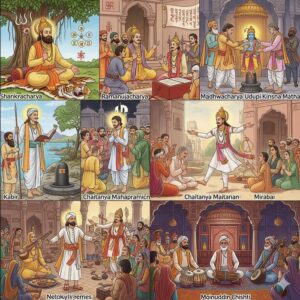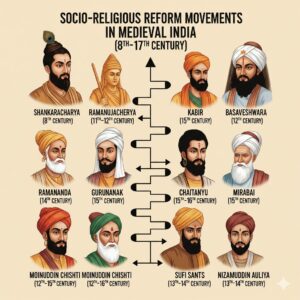2nd PUC History Question and Answer – Socio-Religious Reform Movement In Medieval India
Looking for 2nd PUC History textbook answers? You can download Chapter 6: Socio-Religious Reform Movement In Medieval India Questions and Answers PDF, Notes, and Summary here. 2nd PUC History solutions follow the Karnataka State Board Syllabus, making it easier for students to revise and score higher in exams.
Karnataka 2nd PUC History Textbook Answers—Reflections Chapter 6
Socio-Religious Reform Movement In Medieval India Questions and Answers, Notes, and Summary
2nd PUC History Chapter 6
Socio-Religious Reform Movement In Medieval India
Scroll Down to Download Socio-Religious Reform Movement In Medieval India PDF
I. Answer the following in a word or a sentence each
Question 1.
Which was the birthplace of Shankaracharya?
Answer:
Kaladi, Kerala.
Question 2.
Name the philosophy of Shankaracharya.
Answer:
Advaita (Non-dualism).
Question 3.
Name the philosophy of Ramanujacharya.
Answer:
Vishishtadvaita (Qualified Non-dualism).
Question 4.
Who was the Hoysala King who gave shelter to Ramanujacharya?
Answer:
Vishnuvardhana.
Question 5.
Which was the birthplace of Madhwacharya?
Answer:
Pajaka near Udupi.
Question 6.
What was the earlier name of Madhwacharya?
Answer:
Vasudeva.
Question 7.
Name the philosophy of Madhwacharya.
Answer:
Dwaita (Dualism).
Question 8.
Which was the birthplace of Basaweshwara?
Answer:
Bagewadi.
Question 9.
Who was the Kalachuri King who gave royal patronage to Basaweshwara?
Answer:
Bijjala.
Question 10.
Who presided over the religious discourses at Anubhavamantapa?
Answer:
Allamaprabhu.
Question 11.
Where was Ramananda born?
Answer:
Prayag.
Question 12.
Who is the founder of Sikhism?
Answer:
Gurunanak.
Question 13.
Which is the Holy Book of Sikhs?
Answer:
Guru Granth Sahib.
Question 14.
Answer:
Answer:
Mirabai.
Question 15.
From which word is Sufi derived?
Answer:
Saf (wool).
Question 16.
Who was the founder of Chishti order?
Answer:
Khwaja Abdul Chishti.
Question 17.
Who was the founder of Suharawardi order?
Answer:
Sheik Shahabuddin Suharawardi.
II. Answer the following in two words or two sentences each
Question 1.
Who were the parents of Shankaracharya?
Answer:
Shivaguru and Aryambha.
Question 2.
Why is Shankaracharya called ‘Shanmatha Sthapanacharya’?
Answer:
He unified six cults: Shiva, Vishnu, Surya, Ganesh, Kumara, and Shakti.
Question 3.
Name any two important mathas established by Shankaracharya.
Answer:
Govardhana Peetha at Puri, Sharada Peetha at Sringeri.
Question 4.
Name any two works of Shankaracharya.
Answer:
Viveka Chudamani, Bhajagovindam.
Question 5.
When and where was Ramanujacharya born?
Answer:
1017 CE at Sri Perambadur near Chennai.
Question 6.
Who were the parents of Ramanujacharya?
Answer:
Keshva Somayaji and Kantimati.
Question 7.
Name any two works of Ramanujacharya.
Answer:
Vedanta Sara, Sree Bhashya.
Question 8.
When and where was Madhwacharya born?
Answer:
1238 CE at Pajaka near Udupi.
Question 9.
Who were the parents of Madhwacharya?
Answer:
Madhyageha Narayana Bhatta and Vedavathi.
Question 10.
Name any two mathas established by Madhwacharya.
Answer:
Sodey matha, Pejawara matha.
Question 11.
Name any two works of Madhwacharya.
Answer:
Geetha Bhashya, Brahma Sutra Bhashya.
Question 12.
When and where was Basaweshwara born?
Answer:
1132 CE at Bagewadi.
Question 13.
Who were the parents of Basaweshwara?
Answer:
Madarasa and Madalambike.
Question 14.
Who founded Anubhava Mantapa and where?
Answer:
Basaweshwara at Kalyana.
Question 15.
Name any two important orders among the Sufis.
Answer:
Chishti, Suharawardi.
Question 16.
Name any two important saints of Chishti order.
Answer:
Moinuddin Chishti, Nizamuddin Auliya.
III. Answer the following in 15–20 sentences each
Question 1.
Explain the life and teachings of Shankaracharya
Answer:
Shankaracharya was born in 788 CE at Kaladi in Kerala to Shivaguru and Aryambha. From a young age, he showed little interest in worldly life and, with his mother’s permission, became a sanyasi. He met his teacher, Govinda Bhagawathpada, on the banks of the river Narmada and embraced asceticism.
Shankaracharya traveled extensively across India, visiting Kashmir, Nepal, Banaras, Badarinath, Dwaraka, Puri, Tirupathi, and Kanchi. He established several mathas (monastic centers), with four being particularly important: Govardhana Peetha at Puri, Kalikamatha at Dwaraka, Jyotirmatha at Badrinath, and Sharada Peetha at Sringeri.
He propagated Advaita Philosophy (non-dualism), emphasizing that Brahma is the ultimate reality. Brahma is Nirguna (without attributes), Nirakara (formless), and Swaprakashaka (self-evident). According to him, the material world is Maya (illusion), and the individual soul is identical to the Supreme Soul. He famously said, “Aham Brahmasmi” (I am Brahma). Salvation is attained through Jnana (knowledge) and self-realization.
Shankaracharya also attempted to unify various Hindu cults by giving importance to the worship of Shiva, Vishnu, Surya, Ganesh, Kumara, and Shakti, earning him the title ‘Shanmatha Sthapanacharya’. His important works include Viveka Chudamani, Shivananda Lahari, Ananda Lahari, Soundarya Lahari, and Bhajagovindam. He died at the young age of 32, leaving a profound spiritual and philosophical legacy.
Question 2.
Describe the life and teachings of Ramanujacharya
Answer:
Ramanujacharya was born in 1017 CE at Sri Perambadur near Chennai to Keshva Somayaji and Kantimati. He was educated in Kanchi under Yadhava Prakasha. At the age of 16, he married Tangamma, but feeling discontented with family life, he renounced worldly life and became a sanyasi.
He was meant to succeed Yamunacharya as the head of the Srirangam mutt, but reached there too late. Later, he became the head of the Srirangam mutt and popularized Vaishnavism. Kulottunga Chola, a Shaiva king, opposed him, prompting Ramanuja to move to Karnataka. There, Hoysala King Vishnuvardhana gave him shelter, and he established a Vaishnavamatha at Melukote, where he stayed for 20 years. After Kulottunga’s death, Ramanuja returned to Tamil Nadu and died in 1137 CE at the age of 120.
Ramanujacharya propounded Vishishtadvaita Philosophy (qualified non-dualism), which taught that God (Paramatma) is real, independent, and eternal, and that the soul (Chit) and the material world (Achit) are dependent on Him. He rejected Shankaracharya’s Mayavada. Salvation is attained through Bhakti Marga, which includes:
- Prapatthi – absolute surrender to God
- Acharyaabhimana – obedience and devotion to the guru
He also allowed temple entry for all devotees, regardless of caste, referring to untouchables as Thirukulattar or Shriharikula. His important works include Vedanta Sara, Vedanta Sangraha, Vedanta Sutra, Geetha Bhashya, and Sree Bhashya.
Question 3.
Explain the life and teachings of Madhwacharya
Answer:
Madhwacharya was born in 1238 CE at Pajaka near Udupi to Madhyageha Narayana Bhatta and Vedavathi. His birth name was Vasudeva, and he was also called Poorna Prajna and Ananda Teertha. Madhwacharya became a renowned scholar in the Vedas, Puranas, and history.
He studied under Achuthapreksha, a follower of Advaita philosophy, but later disagreed with his teacher and developed his own philosophy. He traveled widely across North India, visiting Kashi, Badari, Kedara, Haridwara, and Gaya, and on returning, he installed idols of Krishna at Udupi and Balarama at Malpe.
He established Ashta-mathas at Udupi: Sodey, Sirur, Kaniyur, Pejawar, Palimaru, Adamaru, Krishnapura, and Puttige mathas. He also visited important South Indian sacred sites such as Kanchi, Tanjore, Srirangam, Madurai, Rameshwaram, and Kanyakumari. Madhwacharya died at the age of 80.
He propounded Dwaita Philosophy (Dualism), which states that God, soul, and matter are three distinct entities. God (Paramatma) is independent, while the soul (Chethana) and matter (Jada) are dependent on Him. He identified five fundamental differences:
- Soul and God cannot merge
- Soul and soul cannot merge
- Matter and God cannot merge
- Matter and soul cannot merge
- Matter and matter cannot merge
His important works include Geetha Bhashya, Brahma Sutra Bhashya, Anu Bhashya, and Dwadasha Stotra.
Question 4.
Discuss the socio-religious reforms of Basaveshwara
Answer:
Basaveshwara was born in 1132 CE at Bagewadi. He toured the state, creating awareness about social equality and religious reforms. He rejected the caste system and encouraged inter-dining. He gave Linga Deeksha to untouchables such as Nagadeva and performed inter-caste marriages, including that of a Brahmin girl to a Harijan boy.
Orthodox people complained to King Bijjala, accusing Basaveshwara of misusing state funds and corrupting Hinduism. After facing political opposition, Basaveshwara resigned from his ministerial post and moved to Kudalasangama, which led to a revolt in Kalyana. He attained oneness with God in 1168 CE.
He propounded Shaktivishishtadwaitha Philosophy, emphasizing worship of Linga, which symbolizes the union of Shiva (Purusha) and Shakti (Prakriti). Followers, called Lingayaths, were taught the Ashtavarana principles:
- Obedience to Guru
- Worship of Linga
- Reverence for Jangama
- Smearing of Ashes on the forehead
- Wearing Rudraksha
- Sipping Padodaka
- Partaking of food offered to God
- Uttering “Namah Shivaya”
He also established Anubhava Mantapa at Kalyana, a center for religious and social discussions presided over by Allamaprabhu. Basaveshwara’s teachings emphasized devotion, equality, dignity of labor, and inner purity.
Question 5.
Give an account of Kabir and Gurunanak
Answer:
Kabir (1398–1518 CE):
Kabir was born in Varanasi and raised by a Muslim weaver couple, Niru and Neema. A disciple of Ramananda, he preached equality and unity among all castes and religions. Kabir taught that Allah and Rama are one and the same God, and that God is found in the hearts, not in temples or mosques. He condemned idol worship, pilgrimage, and ritualistic practices. His followers, the Kabirpanthis, included both Hindus and Muslims, and his teachings were expressed through devotional Doha poetry.
Gurunanak (1469–1539 CE):
Gurunanak, the founder of Sikhism, was influenced by Kabir. He preached the brotherhood of mankind, opposed idol worship, caste discrimination, sati, and exploitation of the poor. He emphasized truth, devotion, and social justice. Gurunanak attained enlightenment at the age of 30 near Sultanpur and traveled extensively for 30 years spreading his teachings. His disciples are called Sikhs, and the Guru Granth Sahib is the holy scripture of Sikhism, written in Gurmukhi script. Both Kabir and Gurunanak promoted devotion, social equality, religious harmony, and ethical living.
Additional Questions and Answers
I. One-word or one-sentence answers
Question 1.
Who was the teacher of Shankaracharya?
Answer:
Govinda Bhagawathpada
Question 2.
Name the four mathas established by Shankaracharya.
Answer:
Govardhana Peetha (Puri), Kalikamatha (Dwaraka), Jyotirmatha (Badrinath), Sharada Peetha (Sringeri)
Question 3.
What does “Aham Brahmasmi” mean according to Shankaracharya?
Answer:
“I am Brahma”
Question 4.
Which philosophy did Ramanujacharya oppose?
Answer:
Advaita or Mayavada
Question 5.
Who was the head of Srirangam mutt before Ramanujacharya?
Answer:
Yamunacharya
II. Two-sentence answers
Question 1.
Why is Shankaracharya called Jagadguru?
Answer:
Shankaracharya is called Jagadguru because he was regarded as the spiritual teacher of the entire world. He spread Advaita philosophy and established mathas across India.
Question 2.
What is Vishishtadvaita Philosophy?
Answer: Vishishtadvaita is “qualified non-dualism,” which teaches that God (Paramatma) is real, and the soul and world are dependent on Him. It emphasizes devotion (Bhakti) and surrender (Prapatthi) to God.
Question 3.
Name any two important works of Madhwacharya.
Answer:
Geetha Bhashya and Brahma Sutra Bhashya
Question 4.
How did Basaveshwara encourage social equality?
Answer:
He abolished caste discrimination, encouraged inter-caste marriage, and gave Linga Deeksha to all, including untouchables.
Question 5.
Mention two teachings of Kabir.
Answer:
Kabir preached that God is within the heart, not in temples or mosques, and condemned caste discrimination and idol worship.
Question 6.
Mention two teachings of Gurunanak.
Answer:
Gurunanak emphasized truth, devotion, equality among all humans, and opposed social evils like sati and caste discrimination.
III. Short-answer/15–20 sentence type questions
Question 1.
Write a note on Advaita, Vishishtadvaita, and Dwaita philosophies.
Answer:
- Advaita (Shankaracharya): Non-dualism; the individual soul and Brahma are identical; world is Maya (illusion). Salvation through Jnana (knowledge).
- Vishishtadvaita (Ramanujacharya): Qualified non-dualism; soul and world are real but dependent on God; salvation through Bhakti (devotion) and Prapatthi (surrender).
- Dwaita (Madhwacharya): Dualism; soul, matter, and God are distinct; God is independent, and salvation is attained through devotion and understanding the differences between soul and God.
Question 2.
Describe the importance of Sufism in Medieval India.
Answer:
Sufism arose as a spiritual and social reform movement within Islam in medieval India. The term “Sufi” comes from “saf” (wool) symbolizing simplicity or “purity.” Sufi saints blended Islamic teachings with Hindu practices, promoting devotion, tolerance, and harmony. They opposed caste discrimination, social inequality, and orthodox religious rituals. Sufis used music and poetry (Qawwali) as forms of devotion and preached the equality of men and women in spiritual practice. Saints like Moinuddin Chishti, Fariduddin Shakar, and Bahauddin Suhrawardi were widely respected. Their dargas (shrines) became centers of spiritual and social guidance. Both Hindus and Muslims followed their teachings, fostering communal harmony. Sufism helped spread Islam in India in a more inclusive and compassionate way.


